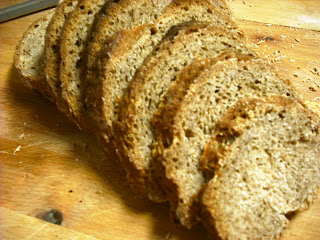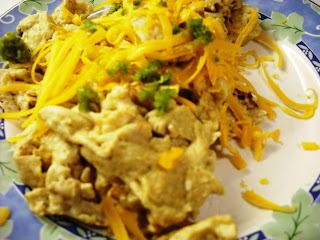
Hi everyone! I've been on unannounced hiatus, I guess. But I'm back, and I'm cooking, and I'm posting, and I know you're hungry.
This morning, I have what I've long promised: Maria's Black Forest cake. I don't know why it's called a Black Forest cake, though I know that there's a black forest in Germany, and I suppose it's named for that place. Because of the kind of cake it is, I suspect it's a forest of cacao plants and cherry trees. If so, it must also be a place full of fairies [why is fairy art so bad?] and sprites and leprechauns and other delightful, yet fictive, folks.
Okay, so now I'm looking up the origins of Black Forest cake. Unusually, Wikipedia is the most conservative. This website, however, is pretty thorough. If, you know, leprechaun-y (cherries as pom-poms? Maaaaaybe...)
So: basically SOMEone at SOMEpoint decided to mix cherries with whipped cream and cake (and cherry brandy) and call it dessert.
What I did -- and Maria's cake is the first I tried -- includes cake and cherries, but not whipped cream or brandy. I may have to rethink these exclusions the next time through (and in fact rethought excluding the whipped cream for the trifle version I made -- in fact, I included GOBS of it.).
This is what I did. Or, honestly, what I think you might do to make a better version even than the cake I made. Or, honestly, what I'd do the next time I do this.
Chocolate cake first.
2 c all-purpose flour
2 c sugar
1 1/2 tsp backing soda
1/4 tsp salt
1 1/2 c milk
1/2 c Crisco
1 tsp vanilla
2 eggs
You'll need an electric mixer.
Grease and flour two 9" round cake pans; if you want to (and I do), line the bottom of the pans with wax paper, which you'll also grease and flour. Preheat the oven to 350.
In a bowl combine the dry ingredients until well mixed. Add milk, Crisco, and vanilla. Beat on high for two minutes.
Add eggs and beat on high for two minutes more. Divide equally into two cake pans.
Bake at 350 for about 30 minutes or until a toothpick inserted in the middle of each cake comes out clean. I usually set the timer for 15 minutes and move the front cake pan to the back and the back cake pan to the front to ensure even baking. Then, of course, reset the timer for fifteen more minutes.
Cool on racks for ten minutes, then remove from the pans and cool on racks until room temperature.
For Maria's cake, I used canned Comstock pie cherries. They did not work the way I wanted to (they are too wet). So instead I recommend getting a can (14.5 oz) of tart cherries. I have the Oregon brand, but you want simply canned tart cherries, not pie cherries in goop.
Drain the cherries, reserving the juice. You should have about a cup and a half of cherries. In a saucepan, mix cherries with 1/3 cup sugar, 1/4 c reserved juice, and 4 tsp. corn starch. Stir to mix. Let stand 10 minutes in the pan, then cook on medium until thickened and bubbly.
Cool to just warm.
Keep cherry juice that's left over, if any, reserved.
Icing:
1/3 c butter
4 1/2 c powdered confectioner's sugar
1/4 c milk
1 1/2 tsp vanilla
Beat butter until fluffy with an electric mixer. Add cocoa powder and beat smooth. GRADUALLY add 2 cups of the powdered sugar, beating well. Beat in the milk and vanilla. Gradually add the rest of the sugar, thinning with dabs of milk to get to spreading consistency; adding more powdered sugar to stiffen, if necessary.
Assembly:
Place bottom layer of cake top-down on a cake plate and place strips of waxed paper [um, okay, not the kind I'm using or the purpose I have for it -- but who can resist a site called "Albumen"?] over the plate around the cake to keep the plate clean as you ice.
Ice the top of cake one inch or so in from the sides all around, and in a separate circle in the center of the layer. Look at the picture if this isn't clear. God knows how to articulate this, but basically you want to make an inverted doughnut shape with the icing. That means, from the edge of the cake, you have a circle of icing, a circle of cherries, a circle of icing. When you cut the cake, then, the layer will look striped with icing and cherries.
In the circle not covered with icing, put half the thickened cherries.
Using a plate to invert the top layer and brush the bottom with reserved cherry juice. DON'T soak it. Just -- brush it. If you want to use cherry brandy at this point. Brush the bottom with that. Remember not to soak it or it'll break apart when you try to put it on top of the bottom layer.
Invert the top later CAREFULLY onto the bottom layer. You should be looking at the top of the top layer (rounded, not flat).
Ice the sides of the cake, leaving a circle open in the center of the top layer. When you're ready to serve, fill this with the rest of the cherries.
If you'd like to, sprinkle with dark chocolate shavings.
There you go. Ummm.






































